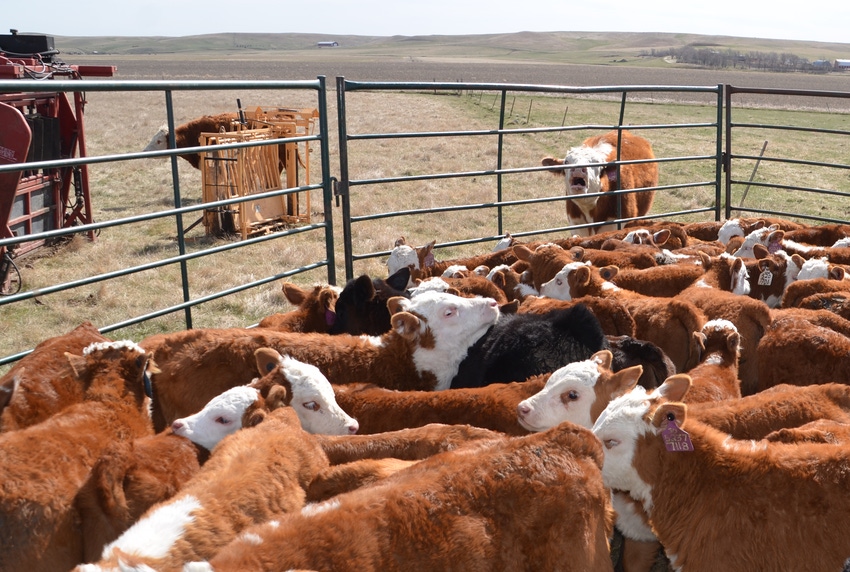Drought across much of cattle country makes early weaning a good option.
July 22, 2020

Sometimes weaning calves early is good strategy, especially on a dry year when forage is short. Reinaldo Cooke, beef cattle production, Texas A&M University, says early weaning has several benefits. “Originally, the purpose for weaning early was so cows would have more time to recover, particularly first-calf heifers,” he explains.
Traditional weaning age is 7 or 8 months. Early weaning is anything before that. “Some people think early weaning is 5 to 6 months, while others think in terms of 2 months. Initially, especially in the Southeast with Brangus, weaning at 2 to 3 months was so first-calf heifers would not have calves at side during breeding season and could rebreed more readily,” he explains.
In addition to lactation demand, a 2-year-old is still growing. Even in a non-drought situation, it helps young cows if you don’t leave calves on them too long. It frees up more nutrients to complete growth and have a healthy pregnancy.
“In the West, weaning at about 5 months (late summer/early fall) is considered early weaning, so cows on fall ranges can recover from lactation,” says Cooke.
David Bohnert, beef Extension specialist/ruminant nutritionist, Oregon State University, says ranchers using public lands generally don’t like to early wean because it means an extra gather off their allotments, assuming they’ll turn cows back out. “There can be advantages to weaning at 120 to 140 days, however,” he says.
“We can improve cow body condition by weaning early when pastures are dry. Our data show that cows go into winter at least one body condition score higher than if we leave calves on until fall.” This is better for next year’s calf crop and breed-back.
“When cows are in better shape going into winter, this means less feed you have to provide. Maintaining them through winter is easier than trying to put weight back on. When you pull that calf off, you reduce cows’ nutrient requirements by about 40%,” he says.
Depending on calf age and size, you can expect a decrease in overall forage intake somewhere between 10% and 60% by early weaning, Bohnert explains. This would extend the time you could be on the range or stretch your home pastures.
Handling calves
“If you wean a young calf, it needs high-quality forage or grain,” says Bohnert. “One advantage to early weaning, if you can retain ownership, is that calves can do well.” Data on this type of feeding show increased marbling, and young calves are more efficient in handling grain than forages.
Cooke says they learn to eat concentrates at a much younger age, so when they go to the feedlot they perform better than calves weaned at 7 months. “When we wean at 2 or 3 months and feed a high-energy diet, we’re training the body early in life to be more efficient when receiving high-energy, anabolic diets in the feedlot,” says Cooke. If these calves will be feedlot cattle, they do well, but heifers destined to be cows need to develop their rumens more fully for efficient forage utilization.
Another option is to market calves at 300 to 400 pounds when you take them off the cow. “You can sell light calves now or feed them awhile and get them into a growing lot and finish them, or winter them to sell as yearlings next spring,” says Bohnert.
It depends on your ranch resources. Depending on where you live, you might find a food-processing byproduct, such as beet pulp, onions or vegetable wastes. If calves are really young, they are not ready for pasture. You need to feed grain to get them bigger first.
Some feedlots are set up for very young calves, but calf health can be an issue. “Even if you vaccinate, young calves don’t always mount good immunity. It can be a challenge sending them to a feedlot; they tend to have more sickness, health costs, and death loss,” says Bohnert. On the other hand, if they still have maternal antibodies (that might interfere with vaccination success), they may stay relatively healthy during this transition.
Consider the options
“Evaluate your resources,” Bohnert says. If it’s a choice between early weaning and buying expensive hay for cow-calf pairs, or having to sell some cows, you might be better off to early wean.
“We did some trials with calves weaned August 1st versus mid-to-late October. Cows traditional-weaned were body condition 4, versus early weaned cows that maintained body condition at 5. To get score 4 cows back up to 5 took about $30 per head (back when feed was less expensive),” he says.
“On average, early weaning will generally decrease winter feed costs 15 to 20%,” says Bohnert. You may not get as much money for calves sold younger, but it may save enough in winter feed costs to be profitable.
“Without calves at side, mature cows adapted to their environment can usually maintain body weight, but cows have gotten bigger,” he says. They’ve been selected for larger frame and more milk production, and don’t do well in harsh conditions if they’re still lactating.
“On most ranches, early weaning during drought can help. In just 80 days without good pasture, lactating cows may lose a body condition score. Depending on cow size, this means you need to put 100 to 150 pounds back on that cow before she calves again,” he explains.
Smith Thomas is a rancher and freelance writer based in Salmon, Idaho. The opinions of the author are not necessarily those of beefmagazine.com or Farm Progress.
About the Author(s)
You May Also Like



